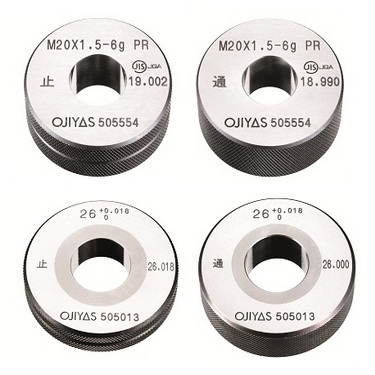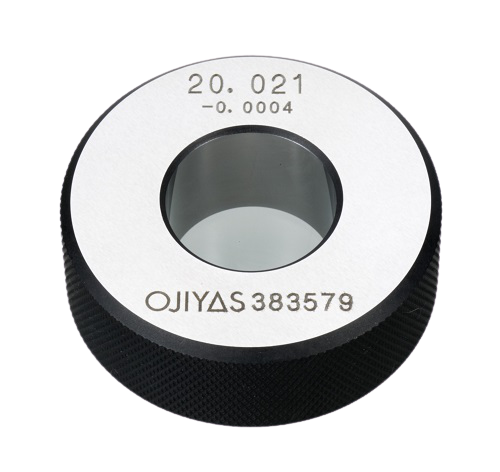A common application in measurement is the checking of holes and shafts. Besides the plug gauge, the diameter of a shaft in manufacturing can be carried out with a ring gauge. The ring gauge provides a Go or No-Go quality check of the outer diameter of a cylindrical object. It can also be used to calibrate a gauge or other measuring hand tools such as a caliper, inner micrometer, or bore gauge. The ring gauge is an inspection tool that is manufactured with precision and has a remarkably tight tolerance.
This article will provide you with information about the types, tolerance sizes, various configurations, and examples of ring gauge products in Singapore.
What is a Ring Gauge?
The ring gauge is a ring-shaped measuring instrument used to measure the outside diameter of cylindrical objects such as pins, shafts, splines, fasteners, dowels, studs, and other parts of the machine. Ring gauges are usually made of stable materials such as chrome plated tool steel and carbide which provide greater service life. This tool is very precise (exceedingly tight tolerance) which is used as an outer diameter gauge.
Function
The main function of the ring gauge is to determine by "go" or "no-go" whether the measured part is in accordance with the specified dimensional tolerance. The use of ring gauges allows inspections of machine parts to be made very quickly without the need to use micrometers, calipers, thickness gauges, or other measuring instruments which can take longer to conclude its quality.
Ring gauges are also effective for checking roundness at higher levels. Measurements with this tool are used as a standard to set the bore gauge, which can then be used to determine whether there are deviations from the nominal size.
Types of Ring Gauge
Ring gauges are divided into three main types, namely:
1. Go Ring Gauge
The go ring gauge is designed to verify the high limit of the outer diameter. If the go ring gauge matches the outside diameter, it indicates the maximum permissible material conditions for the part have not been exceeded. That is, the diameter of the part is within the upper limit of its tolerance, and therefore the part is acceptable. However, if the go ring gauge does not fit on the part being tested, it means that the part diameter is too large and contains excess material, it must be rejected for rework.
2. No-Go Ring Gauge
The no-go ring gauge checks the lower limit of the outer diameter. If the no-go ring gauge does not match the outside diameter, it indicates that the minimum permissible material conditions for the part have been met.
That is, the diameter of the part exceeds the minimum or lower limit of its tolerance, and therefore the part is acceptable.
However, if the no-go ring gauge matches the part being tested, so that there is too much material in excess and the part is below its minimum tolerance value, it must be rejected.
3. Master / Setting Ring Gauge
A master ring gauge (also known as a set ring gauge) is used to calibrate dimensional tools or other measuring instruments. This gauge can zero point alignment before measuring with the inner diameter gauge. For example, by providing measurement standards or reference standards for calibration purposes. This practice is known as indirect gaging.
Ring Gauge Tolerance
Ring gauges are available in a variety of tolerance classes that can be selected according to the specific requirements of the application and the need for precision. We normally use ISO engineering fits to describe ring gauges as it is the internationally accepted standard for defining engineering fits. However, ANSI is still often used in North America region.
The ISO System of Limits and Fits is a coordinated system of hole and shaft tolerances for engineering and manufacturing used for gauges. If held to these tolerances, gauges are available throughout the world. The hole basis fits have hole tolerances like H11, H9, H8, and H7 for instance; the shaft basis fits have shaft tolerances like h11, h9, h7, and h6 for instance.
Below is an example of some common tolerances for nominal diameter sizes 0 to 30 mm.
| Tolerance | Tolerance2 | over 0 to 3 | over 3 to 6 | over 6 to 10 | over 10 to 18 | over 18 to 24 | over 24 to 30 |
| Shafts | h6 | 0.000 -0.006 | 0.000 -0.008 | 0.000 -0.009 | 0.000 -0.011 | 0.000 -0.013 | 0.000 -0.013 |
| Shafts | h7 | 0.000 -0.010 | 0.000 -0.012 | 0.000 -0.015 | 0.000 -0.018 | 0.000 -0.021 | 0.000 -0.021 |
| Shafts | h9 | 0.000 -0.025 | 0.000 -0.008 | 0.000 -0.009 | 0.000 -0.011 | 0.000 -0.013 | 0.000 -0.013 |
| Shafts | h11 | 0.000 -0.060 | 0.000 -0.075 | 0.000 -0.090 | 0.000 -0.110 | 0.000 -0.130 | 0.000 -0.130 |
| Holes | H7 | +0.010 0.000 | +0.012 0.000 | +0.015 0.000 | +0.018 0.000 | +0.021 0.000 | +0.021 0.000 |
| Holes | H8 | +0.014 +0.000 | +0.018 +0.000 | +0.022 +0.000 | +0.027 +0.000 | +0.033 +0.000 | +0.033 +0.000 |
| Holes | H9 | +0.025 +0.000 | +0.030 +0.000 | +0.036 +0.000 | +0.043 +0.000 | +0.052 +0.000 | +0.052 +0.000 |
| Holes | H11 | +0.060 0.000 | +0.075 0.000 | +0.090 0.000 | +0.110 0.000 | +0.130 0.000 | +0.130 0.000 |
In other parts of the world, ring gauges are classified differently. Symbols like XXX, XX, X, Y, Z, ZZ are used instead. Class XXX represents the highest-grade gauge having the tightest tolerances and the tolerances gets looser towards ZZ. The gauges' tolerance which defines the tolerance value as a function of class for various size ranges is shown in Table 1. The table shows that the tolerance value increasing (moving from class XXX to class ZZ). The absolute tolerance value also increases with a larger ring gauge size value.
| Range (Inch) | Tolerance by Class (micro-inch) | ||||||
| > | ≤ | XXX | XX | X | Y | Z | ZZ |
| 0.010 | 0.825 | 10 | 20 | 40 | 70 | 100 | 200 |
| 0.825 | 1.510 | 15 | 30 | 60 | 90 | 120 | 240 |
| 1.510 | 2.510 | 20 | 40 | 120 | 120 | 160 | 320 |
| 2.510 | 4.510 | 25 | 50 | 150 | 150 | 200 | 400 |
| 4.510 | 6.510 | 33 | 65 | 190 | 190 | 250 | 500 |
Table 1. Ring gauge tolerance class
How to Use a Ring Gauge
Here is how to use a ring gauge:
1. Select a ring gauge with the appropriate diameter size.
2. Before use, the surface of the ring gauge is cleaned with a dry cloth.
3. The levers and washers must be securely attached so that the rotation with respect to the substrate can be measured and produce the appropriate level of measurement precision, for example at the zero setting when measuring the internal diameter.
4. The ring gauge only needs to be attached between the lever and the ring.
5. Then record the diameter and scale that you will apply to other objects to explain the results of measuring the scale.
6. After use, wipe again with a dry cloth.
7. Store the ring gauge in a place where the humidity and temperature are stable.
It is particularly important to keep the ring gauge clean and free from dirt (such as oil, chips, fingerprints, etc.). These impurities can affect the performance of the ring gauge, not only during calibration, but also in screw thread inspection applications. The regular use of a tube bristle brush whose size corresponds to the main diameter of the ring gauge will help keep the ring gauge from becoming filled with dirt during use.
Ring Gauge Material and Options
There are several ring gauge configurations used to check several types of materials. The plain ring gauge has a smooth inner diameter and is designed to inspect shafts and cylindrical parts that do not have threads or spline cuts along their faces.
There is also a thread ring gauge, which is used to verify the part that has been threaded along its outer diameter. Ring gauges are available for all thread types, sizes, and pitches, including BSPT, NPFT, NPSM, NPT, NPTF, UNC, UNEF, UNF, UNS and Whitworth.
Inside the thread ring gauge, there are specific configurations for various thread types including ACME thread ring gauge, taper pipe thread ring gauge, straight pipe thread ring gauge, ANPT thread ring gauge, and Pg conduit thread ring gauge (used in fittings used in electrical line work). There is also a mini thread ring gauge commonly used in watches and other miniature mechanisms.
There is also an adjustable ring gauge, which contains 3 slots per set cut at 120° intervals allowing the gauge to be calibrated against plug settings. This capability can reduce production costs by extending the life of the gauge.
Ring Gauges Available at LFC
1. Ojiyas Master Ring Gauge
Ojiyas master ring gauge is also known as setting ring gauge. They are used for comparative gauging as well as for checking, calibrating, or setting of gauges or other standards and maintaining comparator type of measuring instruments.
2. Ojiyas Limit Ring Gauge
Limit ring gauge is a couple of gauges having measurement side with the maximum and minimum limit deviation tolerance of shaft to assure the interchangeability of the shaft. The limit deviation tolerances and the grade of the gauges are determined according to the types of limit ring gauges and applied grade of the shaft.
3. Ojiyas Thread Ring Gauge
Thread ring gauges are metrology tools that are used for gauging the outer diameters of pins, shafts, splines, fasteners, dowels, studs, and other machined cylindrical parts. Ojiyas gauges are fabricated from a stable material (SKS31) with a highly precise (extremely high tolerance) bore in their center that functions as the gauge for the outer diameter of the parts.
Ring Gauge Distributor in Singapore
LFC PTE LTD offers a wide selection of ring gauges from a leading brand in the industry, namely Ojiyas. We offer a variety of gauge sizes and types. Our sales staff will help you find the best gauge for your application. For more information about the products we offer, contact us to discuss your requirements.
Visit our facebook, instagram, youtube and linkedin pages to get the latest updates about industrial equipment.





